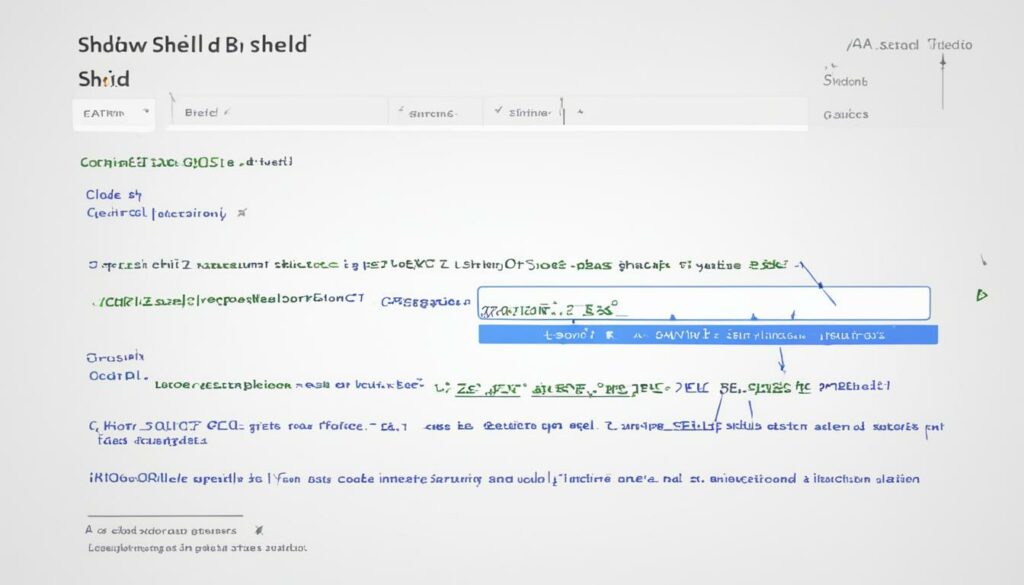In today’s digital world, securing your web applications against cyber threats is of utmost importance. One common and potentially devastating attack is SQL injection, which can lead to the theft or manipulation of sensitive data stored in your database. It’s crucial to understand the vulnerabilities that allow SQL injections to occur and take the necessary steps to protect your web applications.
SQL injection occurs when hackers exploit improper coding in vulnerable web applications, allowing them to insert malicious SQL statements into input fields. These statements can then be executed directly on the database, giving attackers unauthorized access to sensitive information or even compromising your entire server.
To safeguard your web applications against SQL injections, there are several key preventive measures you should implement:
- Parameterized Database Queries: Utilize parameterized queries in your code to separate SQL code from user-supplied data, reducing the risk of SQL injection vulnerabilities.
- Stay Up to Date: Regularly update your software components, including frameworks and server software, to ensure you have the latest security patches and fixes.
- Least Privilege: Provision database accounts with the principle of least privilege, granting only the necessary permissions to minimize the potential impact of an attack.
- Validate User Input: Implement thorough input validation to ensure that user-supplied data matches the expected format and data type, filtering out potentially malicious input.
- Error Handling: Configure proper error reporting and handling to prevent the disclosure of sensitive information and avoid verbose error messages that could aid attackers.
By following these preventive measures, you can significantly reduce the risk of SQL injection vulnerabilities and enhance the security of your web applications.
Key Takeaways
- Prevent SQL injections by implementing parameterized database queries.
- Stay up to date with security patches for all software components.
- Use the principle of least privilege when provisioning database accounts.
- Validate user input to filter out potentially malicious data.
- Configure proper error handling to prevent the disclosure of sensitive information.
What is SQL Injection?
SQL injection is a code injection technique used by attackers to exploit vulnerabilities in web applications. By inserting malicious SQL statements into input fields, attackers can manipulate databases and gain unauthorized access to sensitive information. This technique takes advantage of improper coding practices in vulnerable web applications, allowing the injected SQL statements to bypass security measures and directly interact with the database.
SQL injection poses a significant security risk to web applications, as it enables attackers to steal, modify, or destroy data stored in the database. Moreover, SQL injection can also lead to the elevation of privileges, granting attackers higher levels of access within the application.
Although SQL injection can impact any data-driven application that uses an SQL database, it is most commonly used to target websites. The prevalence of vulnerable web applications makes them attractive targets for attackers seeking to exploit SQL injection vulnerabilities.
To better understand how SQL injection works, consider the following example:
Your website contains a login form with two input fields: username and password. The application retrieves user credentials from the database using an SQL query. However, the developer did not properly sanitize and validate user input, making the login form vulnerable to SQL injection attacks.
An attacker enters the following text in the username field:
admin' --The injected SQL code modifies the original query executed by the application, effectively bypassing the password check. As a result, the attacker gains administrative access to the website, even without providing a valid password.
To protect your web applications from SQL injection, it is crucial to follow secure coding practices, implement input validation, and utilize parameterized database queries. These preventive measures are essential to mitigate the risk of SQL injection vulnerabilities and ensure the security of your application.
Common Methods to Prevent SQL Injection
| Prevention Method | Description |
|---|---|
| Parameterized Queries | Use prepared statements or bind parameters to separate SQL code from user-supplied data, preventing SQL injection attacks. |
| Input Validation | Validate and sanitize user input to ensure only expected data types and formats are accepted, filtering out potentially malicious input. |
| Stored Procedures | Utilize stored procedures to limit direct access to the database and add an additional layer of security. |
| Least Privilege | Provision database accounts with the least privileges necessary to perform their intended functions, reducing the impact of potential SQL injection attacks. |
| Regular Updates | Keep all software components up to date with the latest security patches to mitigate known vulnerabilities that can be exploited in SQL injection attacks. |
Why SQL Injection Poses a Security Risk
SQL injection vulnerabilities in web applications present a significant security risk for businesses. Attackers constantly scan the internet for these vulnerabilities and exploit them using automated tools, seeking potential financial gain.
By exploiting SQL injection vulnerabilities, attackers can gain unauthorized access to sensitive data, such as personally identifiable information, which can then be used for identity theft or sold on the dark web. The financial incentives for such attacks are high, making SQL injection a prevalent and persistent threat.
One of the reasons SQL injection vulnerabilities are so widespread is the prevalence of data-driven web applications accessible via the internet. From e-commerce platforms to financial systems, many applications rely on shared database infrastructure, making them susceptible to exploitation.
| SQL Injection Vulnerabilities | Financial Gain | Shared Database Infrastructure |
|---|---|---|
| Allow attackers to manipulate SQL queries and access unauthorized data | Provide opportunities for stealing sensitive information and committing fraud | Amplify the impact of a single SQL injection flaw across multiple applications |
To illustrate the scope of the problem, consider a scenario where a single application within a shared database infrastructure is compromised due to a SQL injection vulnerability. In this case, the attacker can potentially gain access to other applications sharing the same database, leading to a widespread compromise.
In order to protect sensitive data, it is crucial for businesses to address SQL injection vulnerabilities and implement robust security measures that encompass proper coding practices, regular security updates, and thorough data protection protocols.
Next, we will explore some of the best practices for preventing SQL injection attacks and securing web applications against this significant security risk.
How to Protect Against SQL Injection Attacks
To safeguard your web applications from SQL injection vulnerabilities, there are several key measures you can implement:
- Parameterized Database Queries: Implementing parameterized queries is a crucial step in preventing SQL injections. This approach ensures that user input is treated as data rather than executable code. Parameterized queries can be implemented in various programming languages, including Java, .NET, and PHP.
- Stored Procedures: Utilizing stored procedures provides an additional layer of security by limiting direct access to the database. By using stored procedures, you can minimize the risk of SQL injection attacks.
- Up-to-Date Software Components: Keeping all software components, including frameworks and server software, up to date with the latest security patches is essential. Regular updates help address known vulnerabilities that could be exploited in SQL injection attacks.
By implementing these preventive measures, you can significantly reduce the risk of SQL injection vulnerabilities in your web applications.
Here’s an example of a sample table comparing the recommended measures for protecting against SQL injection attacks:
| Preventive Measure | Description |
|---|---|
| Parameterized Database Queries | Use bound, typed parameters to treat user input as data rather than code. |
| Stored Procedures | Create predefined database procedures to limit direct access and enhance security. |
| Up-to-Date Software Components | Maintain regular updates and patches to address security vulnerabilities in frameworks and server software. |
Implementing these measures will fortify your web applications against SQL injection attacks, ensuring the security and integrity of your data.

Additional Steps for SQL Injection Prevention
In addition to implementing parameterized queries and stored procedures, there are several additional steps you can take to further minimize the risk and impact of SQL injection attacks.
- Use the Principle of Least Privilege: When provisioning database accounts, follow the principle of least privilege. This means granting each account the minimum level of access necessary to perform its intended function. By limiting privileges, you can reduce the potential damage that can be caused by a compromised account.
- Separate Database Accounts: It is recommended to have separate database accounts for different web applications. This ensures that even if one application is compromised, the attacker does not gain access to the entire database. By segregating database accounts, you can contain the impact of a potential SQL injection attack.
- Validate User-Supplied Input: Implement thorough validation of user-supplied input to ensure that it conforms to the expected data types and format. By validating input, you can prevent attackers from exploiting vulnerabilities through carefully crafted malicious inputs.
- Proper Error Reporting and Handling: Configure your web application to provide proper error reporting and handling. Avoid verbose error messages that can potentially expose sensitive information about your database structure or query execution. By providing generic error messages to users and logging detailed errors for administrators, you can prevent attackers from gaining insights into your system.
By following these additional steps, you can enhance the security of your web applications and reduce the risk of SQL injection vulnerabilities.

Best Practices for SQL Injection Prevention
When it comes to securing your web applications, prevention is key. By adopting the following best practices, you can fortify your defenses against SQL injection attacks:
Secure Coding: Utilize secure coding practices and follow guidelines provided by reputable organizations like OWASP. Stay updated with the latest threats and mitigation techniques to ensure your code is robust.
Secure Database: Establish a secure connection between your web application and the database, using encryption and proper access controls. Regularly monitor and audit your database for any suspicious activities.
Role-Based Access Controls: Implement role-based access controls to grant different levels of privileges to users based on their roles. This limits potential damage in case of a compromised account.
Remember that preventing SQL injections requires a multi-layered approach. By following these best practices and continuously monitoring and updating your security measures, you can protect your web applications from SQL injection attacks.
Limitations of Input Filtering
While input filtering plays a role in preventing SQL injections, it is important to understand its limitations. Input filtering and escaping alone are not sufficient to fully protect against SQL injection attacks. Although input filtering can stop some basic attacks, it does not address the underlying vulnerability present in the code.
Attackers can easily bypass filter-based defenses by using alternative characters or techniques that can evade the filters in place. This highlights the need for a comprehensive approach that includes additional preventive measures.
One of the most effective preventive measures is the implementation of parameterized queries. Parameterized queries separate user input from the SQL code, treating input as data rather than executable code. This significantly reduces the risk of SQL injections by eliminating the opportunity for attackers to manipulate the SQL statements.
Additionally, other preventative measures such as input validation, stored procedures, and regular updates to software components are essential in creating a robust defense against SQL injection attacks.
“Input filtering is a valuable first line of defense, but it should be complemented by other security measures to ensure comprehensive protection against SQL injection vulnerabilities.” – Your Website Security Team
Limitations of Input Filtering:
- Not addressing underlying vulnerabilities in code
- Possible bypassing of filter-based defenses
Preventive Measures:
- Implement parameterized queries
- Perform input validation
- Use stored procedures
- Maintain regular software component updates
By understanding the limitations of input filtering and adopting a multi-layered approach to SQL injection prevention, you can effectively safeguard your web applications and protect sensitive data from malicious attacks.
| Advantages | Limitations |
|---|---|
| Provides initial protection | Does not address code vulnerabilities |
| Helps stop some basic attacks | Can be bypassed by alternative techniques |
| Easy to implement | Not a comprehensive solution |

Remember, preventing SQL injections requires a holistic approach that goes beyond relying solely on input filtering. Implementing parameterized queries and additional security measures will go a long way in fortifying your web applications against these potentially devastating attacks.
Simple SQL Injection Example
Understanding how SQL injection works is vital to protect your web applications from potential attacks. In this section, we will walk you through a simple SQL injection example that demonstrates how attackers can bypass authentication and gain unauthorized access, emphasizing the importance of implementing proper input validation and parameterized queries.
Imagine you have a web application where users can log in with their username and password. The application’s login functionality includes an SQL query that checks the entered credentials against the database:
SELECT * FROM users WHERE username = '[username]' AND password = '[password]';
If the supplied username and password match an entry in the database, the user is authenticated and granted access. However, if an attacker attempts an SQL injection attack by manipulating the input fields, they can inject malicious SQL code that alters the query’s behavior. For example, they could enter the following in the username field:
' OR 1=1; --
With this input, the modified query becomes:
SELECT * FROM users WHERE username = '' OR 1=1; --' AND password = '[password]';
Here’s how the injection works:
- The attacker closes the single quotes in the username parameter by entering ‘,
- They add OR 1=1, which is always true, resulting in the query returning all rows from the “users” table,
- To comment out the remainder of the query and bypass the password check, they append —
With this manipulation, the database will find a match for the injected SQL statement, allowing the attacker to bypass the authentication process and gain administrator privileges. This grants them unauthorized access to the application and potentially exposes sensitive data.
To prevent this type of attack, developers must implement proper input validation and parameterized queries. Input validation ensures that user input meets the expected format and eliminates any special characters that could alter the query’s behavior when executing it. Parameterized queries separate the SQL code from user-supplied data, preventing attackers from injecting malicious code into the query.
Summary:
In summary, this simple SQL injection example highlights the importance of implementing comprehensive security measures to protect against this type of attack. By validating user input and utilizing parameterized queries, you can significantly reduce the risk of SQL injection vulnerabilities and safeguard your web applications from potential authentication bypass attempts.

Example of Union-Based SQL Injection
Union-based SQL injection is a widely used technique by attackers to extract additional data from a database by combining the results of multiple SQL queries. This method involves injecting a carefully crafted payload into a vulnerable parameter, allowing the attacker to modify the original query and retrieve sensitive information from the database.
Let’s illustrate this technique with an example:
Suppose you have a web application that allows users to search for products based on various criteria, such as price, category, and brand. The application constructs an SQL query dynamically based on the user’s input. The query may look something like this:
SELECT * FROM products WHERE category = 'Electronics' AND priceAn attacker can exploit this vulnerable parameter by injecting a payload into the input field. In this case, the attacker adds a UNION operator and crafts their own query to retrieve data from a different table, such as the “users” table, which may contain sensitive information:
' UNION SELECT username, password FROM users--
The injected payload modifies the original query to become:
SELECT * FROM products WHERE category = 'Electronics' AND price This modified query combines the results of the original query, retrieving product information, with the results of the attacker’s query, which extracts usernames and passwords from the “users” table.
This union-based SQL injection technique allows the attacker to extract data from a table that may not be directly accessible through the application, bypassing any access controls that are in place.
Extracted Data:
| Username | Password |
|---|---|
| admin | secretpassword |
| johndoe | password123 |
| janedoe | pass123word |
| … | … |
As demonstrated in this example, union-based SQL injection can be a powerful attack vector that allows attackers to extract sensitive data from a database. It emphasizes the importance of implementing proper input validation and parameterized queries to prevent such vulnerabilities.
How to Prevent SQL Injections
Preventing SQL injections is a critical aspect of securing your web applications and protecting your valuable data. By employing safe programming techniques and implementing input validation, you can significantly reduce the risk of SQL injection vulnerabilities.
To prevent SQL injections, it is essential to utilize parameterized queries, also known as prepared statements. Parameterized queries separate the SQL code from user-supplied data, ensuring that user input is treated as data rather than executable code. This technique prevents attackers from injecting malicious SQL statements into your web application.
Input validation is another crucial step in preventing SQL injections. By validating user-supplied input, you can ensure that only expected data types are accepted. This process filters out any potential malicious input that could exploit vulnerabilities in your application.
“Prevent SQL injections by using safe programming techniques such as parameterized queries and implementing input validation.”
By following these best practices, you can create a robust defense against SQL injection vulnerabilities in your web applications.
| Best Practices to Prevent SQL Injections |
|---|
| Utilize parameterized queries (prepared statements) |
| Implement input validation to filter out malicious input |
It is important to note that preventing SQL injections requires a holistic approach. While parameterized queries and input validation are crucial, they should be complemented by other security measures, such as secure coding practices, regular software updates, and ongoing vulnerability testing.
By prioritizing SQL injection prevention and implementing safe programming techniques, you can safeguard your web applications and protect them from potentially devastating cyber attacks.
We recommend WordPress Hosting from BoostedHost for optimal performance. Sign up now through this link: www.boostedhost.com/wordpress-hosting.
Best Practices for Handling SQL Injections
When it comes to preventing SQL injections, secure coding practices are essential. By following guidelines provided by organizations like OWASP and staying updated on the latest threats and mitigation techniques, developers can significantly reduce the risk of SQL injection vulnerabilities.
Here are some recommended best practices for handling SQL injections:
- Implement proper input validation and sanitization: Validate user input to ensure it meets the expected data type and format. Remove or escape characters that may have malicious intent.
- Use a secured database connection: Establish a secure connection between your web application and the database server to protect sensitive data.
- Implement role-based access controls: Restrict database access based on user roles and privileges. This helps prevent unauthorized access and limits the impact of potential SQL injection attacks.
- Monitor, test, and patch vulnerabilities: Regularly monitor your application for any suspicious activities or unauthorized access attempts. Conduct thorough testing to identify and mitigate potential security vulnerabilities. Keep all software components up to date with the latest security patches to protect against known vulnerabilities.
By following these best practices, you can enhance the security of your web application and minimize the risk of SQL injection attacks.
To provide optimal performance, we recommend using WordPress Hosting from BoostedHost. Sign up now through this link: www.boostedhost.com/wordpress-hosting.
Conclusion
Ensuring the security of your web applications and protecting sensitive data is of utmost importance. One particular threat that you must be aware of and actively prevent is SQL injections. By implementing a few essential practices, you can significantly reduce the risk of SQL injection vulnerabilities and safeguard your web applications against cyber attacks.
Firstly, it is crucial to implement parameterized queries and stored procedures. These techniques separate SQL code from user-supplied data, ensuring that any input is treated as data rather than executable code. This mitigates the risk of malicious SQL statements being injected into your application.
In addition to parameterized queries, input validation is vital. By validating user-supplied input and accepting only expected data types, you can effectively filter out potential malicious input. This is particularly important as input filtering alone is not enough to prevent SQL injections.
Furthermore, ongoing maintenance is essential for the long-term security of your web applications. This includes keeping software components up to date with the latest security patches and regularly testing for vulnerabilities. Additionally, educating your developers on secure coding practices will ensure they have the knowledge and skills to identify and prevent SQL injection vulnerabilities.
FAQ
Q: What is SQL injection?
A: SQL injection is a code injection technique used by attackers to insert malicious SQL statements into input fields on web applications. This technique takes advantage of vulnerable applications and allows the execution of unauthorized SQL queries on a database.
Q: Why is SQL injection a security risk?
A: SQL injection vulnerabilities pose a significant security risk because they can lead to the theft, modification, or destruction of sensitive data. Attackers can exploit these vulnerabilities to gain unauthorized access, elevate privileges, and even compromise the entire server.
Q: How can I protect against SQL injection attacks?
A: To protect against SQL injection attacks, you should implement parameterized database queries, which separate SQL code from user input. Additionally, using stored procedures, keeping software components up to date, and validating user input are essential preventive measures.
Q: What additional steps can I take to prevent SQL injections?
A: You can further minimize the risk of SQL injection attacks by applying the principle of least privilege when provisioning database accounts, separating accounts for different web applications, configuring proper error handling, and preventing verbose error messages that can aid attackers.
Q: Are input filtering and escaping enough to prevent SQL injections?
A: No, input filtering and escaping alone are not sufficient to prevent SQL injections. While they can help stop some basic attacks, they do not address the underlying vulnerability in the code. A comprehensive approach that includes parameterized queries and other preventive measures is necessary for effective protection.
Q: Can you provide an example of a simple SQL injection?
A: Certainly. An example of a simple SQL injection is when an attacker manipulates input fields, such as the username and password, within the application’s SQL query. By injecting malicious SQL code, the attacker can trick the database into authenticating them as an administrator, granting unauthorized access.
Q: Can you explain union-based SQL injection with an example?
A: Union-based SQL injection is a technique where an attacker combines the results of multiple SQL queries to extract additional data from a database. By injecting a crafted payload into a vulnerable parameter, the attacker can modify the original query to include their own query and retrieve sensitive information from the database.
Q: How can I prevent SQL injections?
A: Preventing SQL injections can be achieved by following safe programming techniques, such as using parameterized queries (prepared statements) and performing input validation to filter expected data types. By implementing these practices, you can significantly reduce the risk of SQL injection vulnerabilities.
Q: What are the best practices for handling SQL injections?
A: The best practices for handling SQL injections include secure coding practices, such as using a secured database connection, implementing role-based access controls, regularly updating knowledge on secure coding guidelines, and performing ongoing monitoring, testing, and patching of vulnerabilities.
Q: How important is preventing SQL injections for securing web applications?
A: Preventing SQL injections is crucial for securing web applications and protecting sensitive data. By implementing preventive measures and following secure coding practices, businesses can better safeguard against cyber attacks and maintain the integrity of their web applications.












